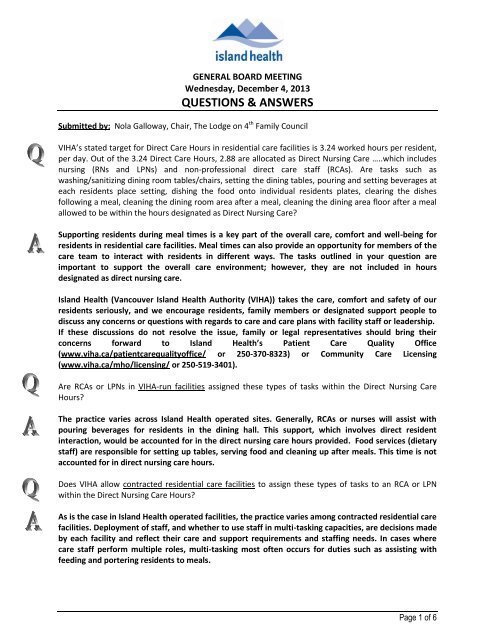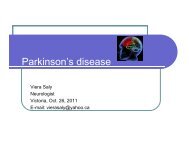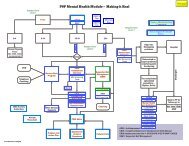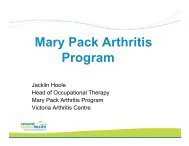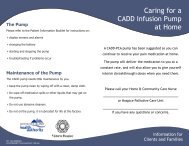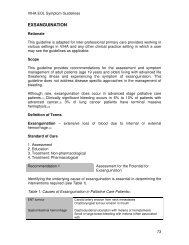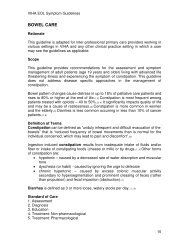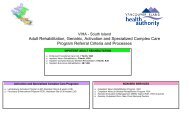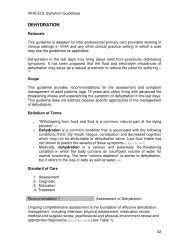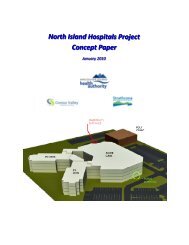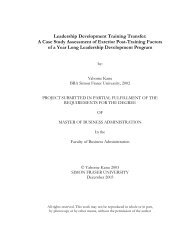Questions & Answers - Vancouver Island Health Authority
Questions & Answers - Vancouver Island Health Authority
Questions & Answers - Vancouver Island Health Authority
Create successful ePaper yourself
Turn your PDF publications into a flip-book with our unique Google optimized e-Paper software.
GENERAL BOARD MEETINGWednesday, December 4, 2013QUESTIONS & ANSWERSSubmitted by: Nola Galloway, Chair, The Lodge on 4 th Family CouncilVIHA’s stated target for Direct Care Hours in residential care facilities is 3.24 worked hours per resident,per day. Out of the 3.24 Direct Care Hours, 2.88 are allocated as Direct Nursing Care …..which includesnursing (RNs and LPNs) and non-professional direct care staff (RCAs). Are tasks such aswashing/sanitizing dining room tables/chairs, setting the dining tables, pouring and setting beverages ateach residents place setting, dishing the food onto individual residents plates, clearing the dishesfollowing a meal, cleaning the dining room area after a meal, cleaning the dining area floor after a mealallowed to be within the hours designated as Direct Nursing Care?Supporting residents during meal times is a key part of the overall care, comfort and well-being forresidents in residential care facilities. Meal times can also provide an opportunity for members of thecare team to interact with residents in different ways. The tasks outlined in your question areimportant to support the overall care environment; however, they are not included in hoursdesignated as direct nursing care.<strong>Island</strong> <strong>Health</strong> (<strong>Vancouver</strong> <strong>Island</strong> <strong>Health</strong> <strong>Authority</strong> (VIHA)) takes the care, comfort and safety of ourresidents seriously, and we encourage residents, family members or designated support people todiscuss any concerns or questions with regards to care and care plans with facility staff or leadership.If these discussions do not resolve the issue, family or legal representatives should bring theirconcerns forward to <strong>Island</strong> <strong>Health</strong>’s Patient Care Quality Office(www.viha.ca/patientcarequalityoffice/ or 250-370-8323) or Community Care Licensing(www.viha.ca/mho/licensing/ or 250-519-3401).Are RCAs or LPNs in VIHA-run facilities assigned these types of tasks within the Direct Nursing CareHours?The practice varies across <strong>Island</strong> <strong>Health</strong> operated sites. Generally, RCAs or nurses will assist withpouring beverages for residents in the dining hall. This support, which involves direct residentinteraction, would be accounted for in the direct nursing care hours provided. Food services (dietarystaff) are responsible for setting up tables, serving food and cleaning up after meals. This time is notaccounted for in direct nursing care hours.Does VIHA allow contracted residential care facilities to assign these types of tasks to an RCA or LPNwithin the Direct Nursing Care Hours?As is the case in <strong>Island</strong> <strong>Health</strong> operated facilities, the practice varies among contracted residential carefacilities. Deployment of staff, and whether to use staff in multi-tasking capacities, are decisions madeby each facility and reflect their care and support requirements and staffing needs. In cases wherecare staff perform multiple roles, multi-tasking most often occurs for duties such as assisting withfeeding and portering residents to meals.Page 1 of 6
GENERAL BOARD MEETINGWednesday, December 4, 2013QUESTIONS & ANSWERSWhen multi-tasked staff are deployed, contracted residential care facilities may only report carerelatedactivities as part of their direct care accountabilities (care hours). As such, a staff memberfeeding a resident is considered to be providing direct care when the resident has an assessed needfor this support. The same staff person providing housekeeping functions, cleaning the dining areaand preparing meals would not be considered to be performing a direct care-related activity, and thistime would not be reported as direct care hours. <strong>Island</strong> <strong>Health</strong> recognizes that nutritional intake iscrucially important in maintaining the health of residential care clients and monitors clients’ intake ofnutrition closely.Submitted by: Adriane Gear, RN Co Chair South <strong>Island</strong>s Region & Provincial Council Member BritishColumbia Nurses’ UnionDespite repeated requests for evidence and a Freedom of Information request that has not beenresponded to, VIHA has failed to provide research that supports its assertion that Care Delivery ModelRedesign (CDMR) Patient Care Model is better for patients, providing a higher level of care. Why willVIHA not provide the research or evidence that supports their decision to implement CDMR Patient CareModel to the nurses and the public?<strong>Island</strong> <strong>Health</strong> is committed to transparency and openness with staff and other stakeholders, includingour union partners. Since <strong>Island</strong> <strong>Health</strong> first began work on CDMR in 2007, we have shared extensiveinformation with our staff and unions during training and information sessions and in face-to-facemeetings. <strong>Island</strong> <strong>Health</strong> has been processing the Freedom of Information request. As part of this, wehave been able to make a routine release of information (i.e. outside the FOI process) to the BCNU.This routine release includes background as well as current information regarding CDMR and thePatient Care Model.In October, VIHA medical managers shared with staffs, as did VIHA admit to BCNU that the CDMRPatient Care Models for medical units as a result of “concerns raised” CDMR Patient Care Model wouldbe “adjusted up” to increase professional nursing hours and return LPNs to the model. Now, VIHA istelling us that this is not possible financially. Does VIHA maintain the position that replacing RNs andLPNs with care aides is not about money?The core objective of the CDMR work has always been to plan for, and respond to, a predictedshortage in health human resources and changing care needs of patients. Our aging workforce,scarcity of health professionals and changing requirements around health care services were drivingthe need to redesign the way care was delivered. CDMR was developed to address these challenges.The initial Functional Analysis studies showed the issues facing our workforce were more than just thenumbers of staff: They extended to the way care was being delivered, meaning even if staff challengeswere addressed, the care needs of patients would still not be adequately met. As a result, CDMRevolved to focus on identified gaps in care, including lack of care planning and lack of communicationbetween care providers and with patients and families. The interdisciplinary care team is key tomeeting the care needs of patients. These teams are recognized as best practice in meeting thecomplex needs of elderly populations.Page 2 of 6
GENERAL BOARD MEETINGWednesday, December 4, 2013QUESTIONS & ANSWERSBudgets and managing sustainable health care services will always be a consideration in a publiclyfunded system. In British Columbia, health care spending accounts for 42% of the total provincialbudget. Costs need to be managed and the rate of spending growth slowed. Investing more and moremoney into the health care system does not improve outcomes. Things need to be done differently.This includes investing in health-focused programming, addressing the social determinants of healthand focusing less on services that deal strictly with illness.<strong>Island</strong> <strong>Health</strong> fully acknowledges that health care aides cost the health care system less and will resultin some cost avoidance; however, this is limited by our commitments to no job losses for RNs, thecreation of relief lines and float pools and the costs associated with the training, support and programimplementation.Care Aides are a welcome addition to existing care teams. They can help patients with activities of dailyliving, but they are not trained or licensed to assess the signs and symptoms of illness and infection.VIHA’s plan to significantly increase the number of patients each nurse is responsible for reduces thetime available for direct patient observation and the detection of reactions or emerging conditions. Howis this good for patient care?Registered Care Aides (RCAs) will play an integral part of the health care team on patient care units byhelping patients carry out ‘activities of daily living’ functions such as bathing, going to the bathroomand eating. These functions are essential in supporting patients to get better and prepare for aneventual return home. Having RCAs perform this role in turn frees up RN time to carry out morecomplex tasks that RNs are trained for such as assessing patients, completing care plans andcommunicating with patients and their families. RNs will still be closely involved with their patients,including doing assessments and carrying out observations.We want to know why exactly VIHA refuses to halt the CDMR Patient Care Model implementation untilan independent review of the model’s impacts on patient safety can be done and the results shared withthe public and the nurses?The aim and purpose of CDMR and the Patient Care Model is to improve patient care. <strong>Island</strong> <strong>Health</strong> iscommitted to moving ahead with the implementation of the model. To ensure that the patient caremodel changes meet their aim and purpose, we are closely monitoring specific outcomes. Theoutcome data being monitored includes patient/family concerns, patient experience scores, lengths ofstay, timely completion of 48/6 assessments, staff satisfaction, staff overtime and sick time rates, etc.VIHA’s CDMR “Fact Sheet” September 2013 rationalizes the implementation of CDMR Patient CareModel in response to address high overtime and vacancy rates. Has VIHA considered the following? Isthe CDMR Patient Care Model about providing safe ethical care, or is it about managing metrics?An analysis of overtime would likely demonstrate that overtime is relied upon in specialty areas(Intensive Care, Emergency, and etc). If specialty training was offered, VIHA could address the specialtynursing shortage and save on overtime costs.Page 3 of 6
GENERAL BOARD MEETINGWednesday, December 4, 2013QUESTIONS & ANSWERSperiod 48 hours out. In response to this challenge, resources have recently been reallocated inCampbell River and Nanaimo, with changes being made in Victoria in January. We understand nurseswould like more contact with schedulers and when we have the technology in place to controltimekeeping and application of the Collective Agreements, we are committed to decentralize someaspects of the function again.Posting and filling of vacancies—per the NBA collective agreement, the posting period is 10 days. VIHAdisclosed that it takes them 120 days to fill a vacancy. The time it takes to post a position and the firstday the successful applicant works it is 4 months!<strong>Island</strong> <strong>Health</strong> is always looking for ways to improve the selection process. We agree it sometimestakes a long time to fill a position. There are a number of RN vacancies currently posted. Some ofthese are for specialty nurses - positions which are more difficult to fill. There is a selection freezecurrently in place in order to accommodate the staffing shifts required around the implementation ofthe 37.5 hour work week and the patient care model.Vacancies—it is stated in the “Fact Sheet” that 58 permanent RN vacancies at VGH and 55 permanentRN vacancies at RJH. Documents dated October 23rd 2013 and received by BCNU on October 31stindicates that there are only 12 permanent vacancies at VGH, two on CDMR impacted units, and 2permanent vacancies at RJH, neither on a CDMR unit.Nurses continue to be in demand across Canada. <strong>Island</strong> <strong>Health</strong> is unable to find nurses forapproximately 12% of entry-level RN jobs in our facilities. This equates to 251 Full Time Equivalent(FTE) RN positions (about 300 positions in total). Given the size of our RN work force, the number ofvacancies is constantly fluctuating. Regardless of how many vacancies exist, <strong>Island</strong> <strong>Health</strong> has made acommitment that there will be a position available for every nurse currently working on the patientcare model units.Submitted by: Brenda Hill, BC Nurses Union Pacific Region ExecutiveWhy did the IH Board visit Mount Waddington on Sept 30th, Oct 1st and 2nd and not hold a meetingopen to the public?The <strong>Island</strong> <strong>Health</strong> Board has met in Mount Waddington annually since the inception of <strong>Island</strong> <strong>Health</strong>in 2001. During this time, we have unfortunately found the public meeting was generally sparselyattended. As a result, <strong>Island</strong> <strong>Health</strong> changed the format and moved to meetings with the MountWaddington <strong>Health</strong> Network, which are open to the public, as a more effective use of time andresources. This group represents a wide cross section of community members, communityorganizations, First Nations and local and regional government.Unfortunately, for our recent board meeting in September/October, the Mount Waddington <strong>Health</strong>Network was unable to convene a meeting with the <strong>Island</strong> <strong>Health</strong> board. <strong>Island</strong> <strong>Health</strong>’s boardmeetings are set a year in advance and we were unable to move our visit to accommodate theiravailability. As a result, the Board instead met with the Mount Waddington <strong>Health</strong> Network SteeringCommittee which is comprised of representatives from the organizations named above. We gavealready request that every effort be made to schedule a meeting with the full network in September2014.Page 5 of 6


